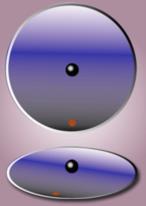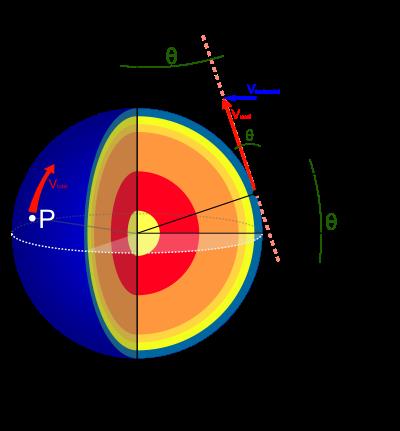
NavList:
A Community Devoted to the Preservation and Practice of Celestial Navigation and Other Methods of Traditional Wayfinding
Re: Coriolis and gyros
From: Gary LaPook
Date: 2009 Aug 20, 19:40 +0200
From: Gary LaPook
Date: 2009 Aug 20, 19:40 +0200
I don't claim to be a physicist but what I know about coriolis is that
it creates an apparent or fictitious force on an object moving
across a rotating reference frame, in our case the earth. This force is
proportional to the speed over the ground and it is also proportional
to the sine of the latitude. So, a gyrocompass in a ship tied to the
dock located at the equator should not experience any coriolis force on
two counts. First, it is not moving across the surface, and second, the
sine of zero latitude is zero and zero times anything is also zero. Yet
a gyro compass will quickly seek north when tied to a dock located at
the equator so it can't be ol man coriolis doing the deed.
The common formula for calculating the coriolis correction to bubble sextant observations is Z = 2.62 times the ground speed (in hundreds of knots) times the sine of the latitude.The 2.62 is a just a constant to connect ground speed in hundreds of knots to the correction in nautical miles (or minutes of deflection of the vertical if you want to think of it that way. ) Using a bubble sextant on the ground requires no correction for coriolis because the ground speed of a person standing in his backyard is zero and zero times anything is still zero. Nor could coriolis be the explanation for he north seeking ability of Douglas' theodolite even though he is located 51º north of the equator since his theodolite also is not moving.
The common illustration for coriolis is someone rolling a ball across a turning merry-go-round but if he does not roll the ball but just keeps it in his hand then there is no coriolis because the ball is not moving across the turning reference frame.
See the attached links.
gl
http://scienceworld.wolfram.com/physics/CoriolisAcceleration.html
http://scienceworld.wolfram.com/physics/CoriolisForce.html
frankreed@HistoricalAtlas.com wrote:
The common formula for calculating the coriolis correction to bubble sextant observations is Z = 2.62 times the ground speed (in hundreds of knots) times the sine of the latitude.The 2.62 is a just a constant to connect ground speed in hundreds of knots to the correction in nautical miles (or minutes of deflection of the vertical if you want to think of it that way. ) Using a bubble sextant on the ground requires no correction for coriolis because the ground speed of a person standing in his backyard is zero and zero times anything is still zero. Nor could coriolis be the explanation for he north seeking ability of Douglas' theodolite even though he is located 51º north of the equator since his theodolite also is not moving.
The common illustration for coriolis is someone rolling a ball across a turning merry-go-round but if he does not roll the ball but just keeps it in his hand then there is no coriolis because the ball is not moving across the turning reference frame.
See the attached links.
gl
http://scienceworld.wolfram.com/physics/CoriolisAcceleration.html
http://scienceworld.wolfram.com/physics/CoriolisForce.html
frankreed@HistoricalAtlas.com wrote:
As Douglas Denny stated originally (later withdrawn), the Coriolis acceleration is most definitely responsible for the north-seeking capability of a gyro-compass (IF you work in coordinates rotating with the Earth --the natural coordinates for these problems). Just make sure you use the full three-dimensional vector cross-product when thinking about the strength of the Coriolis acceleration. The Coriolis acceleration is frame-dependent --it depends on the choice of a rotating frame of reference. It's intriguing to note that there is also an extremely tiny physical, non-frame-dependent, version of the Coriolis acceleration which is created by spinning masses. This is known as "frame-dragging" or "gravito-magnetism" and was measured (barely due to various problems with the ultra-sensitive gyroscopes) by a spacecraft known as "Gravity Probe B": http://einstein.stanford.edu/highlights/status1.html. There is a deep, non-accidental analogy between the Coriolis force and the common magnetic force. And just as a spinning current loop experiences a torque which causes it to precess in a constant magnetic field, a spinning "mass loop" (a.k.a. a gyroscope) experiences a torque which causes it to precess in a rotating frame of reference. Finally, for Gary, there is nothing "fictional" about the so-called "fictitious forces" in rotating frames of reference. They are every bit as real as the common acceleration of gravity, or, if you like, they are every bit as un-real. The complicated explanations for various phenomena which you have learned that avoid using the expression Coriolis are un-necessary, though they can serve as useful reminders that physics can be done in different frames of reference and the results have to be the same no matter what. -FER --~--~---------~--~----~------------~-------~--~----~ NavList message boards: www.fer3.com/arc Or post by email to: NavList@fer3.com To , email NavList-@fer3.com -~----------~----~----~----~------~----~------~--~---










